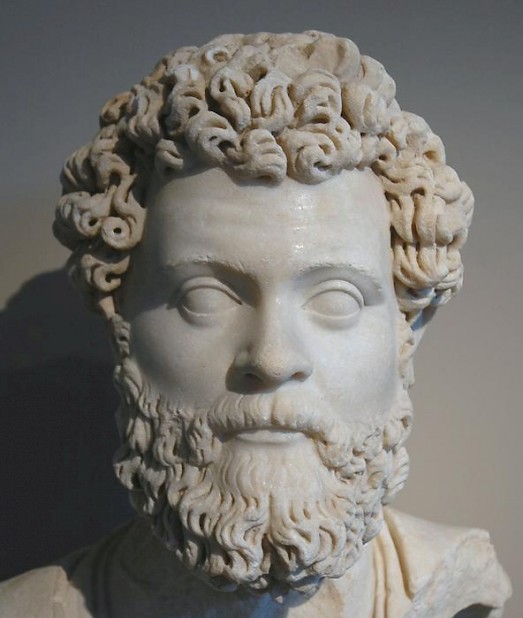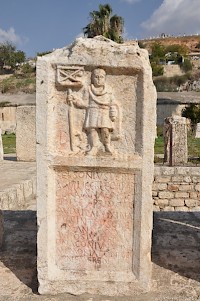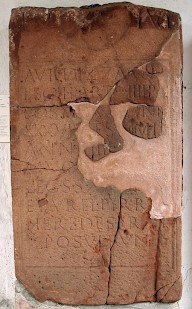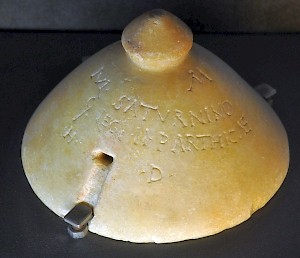Legio II Parthica
Legio II Parthica: one of the Roman legions. Its name indicates that it was recruited to fight against the Parthians, but it usually was Rome's strategical reserve, stationed in Italy.

This army unit and its sisters I Parthica and III Parthica were founded in 197 by the emperor Lucius Septimius Severus, who used them in his war against the Parthian empire. According to the Roman historian Cassius Dio, the First and the Third remained in the region, but the Second was transferred to the Alban mountain near Rome, where it occupied a fortress on the Alban mountain near Rome.note Therefore, it was usually called "The Albanian legion", whereas the soldiers were colloquially known as "the Albanians".
Archaeologists have excavated the cemetery of Alba and we possess many tombstones of former legionaries, who had the habit to call themselves veterani Augusti nostri. A remarkable aspect is that they usually mention their centuria (battalion). This is even more remarkable because legionaries of II Parthica who had died far away from Alba (on the Danube or in the east) had the same tombstones.
This custom is almost unique; only the veterans of II Traiana Fortis at Alexandria had the same custom. It suggests that the soldiers of the Second Parthian legion were recruited among those of the Second Trajan legion, but it should be stressed that there is no evidence for this hypothesis, and it is certain that in the 230s, most legionaries were recruited in the Illyrian provinces.
Of course, a legion in Italy did not serve the protection of the frontier. It was a police force to control Rome and Central Italy, but was equally important as a strategic reserve. Too often in the second century, the Romans had been forced to move legions from one region to protect another, leaving the first region vulnerable to foreign invaders. From now on, it was always possible to send the Second Parthian legion and the imperial (or praetorian) guard from Alba and Rome to the threatened border zone. It is likely that the commander of the imperial guard, the praetorian prefect, was the superior of the commander of II Parthica.

The strategic reserve was probably used by Septimius Severus during the British campaign of 208-211, and very probably by his son and successor Caracalla during his war against the Alamanni in 213. The evidence for this second expedition (inscriptions from Worms), however, may also refer to the Germanic wars of Severus Alexander and Maximinus Thrax (234-236). II Parthica certainly fought against the Parthians in 214-217, because it is known that its commander was involved in the murder of Caracalla and the succession of the commander of the imperial guard, Macrinus.
In the winter of 217/218, it stayed at Apamea in Syria, where it sided with a new pretender: Caracalla's relative Bassianus, better known as the emperor Heliogabalus, who had already gained support of III Gallica. After his succession, the legion was rewarded with the surname Pia Fidelis Felix Aeterna ("for ever faithful, loyal and lucky"). It seems that the soldiers who had been killed in action, were buried as group with special tombstones.
II Parthica had some political influence. A former praetorian prefect, Triccianus, was executed because he had once treated the soldiers harshly.
Together with Heliogabalus, the legion returned to Rome (218/219). It is possible that it had been away from Italy for eleven years, if II Parthica had indeed taken part in the campaigns in Scotland, against the Alamanni, and in the east. In 220, the soldiers honored their emperor with an altar dedicated to Victoria eterna.
In 231, the emperor Severus Alexander set out for the east to fight against a new power in Mesopotamia and Syria: the Sasanians, a new Persian dynasty that had replaced the Parthians. Again, II Parthica had its winter quarters in Apamea. During the war, the expansion of the Sasanian empire was halted at the Euphrates. The inscriptions from Apamea mentioned above may also belong to these years.

After this success, the emperor marched through Illyricum to the Danube and Rhine (234), where II Parthica played a role in the war against the Germanic Alamanni. Its soldiers were present at Mainz when Severus Alexander was killed (235). Later, they loyally supported his successor Maximinus the Thracian, who victoriously concluded the Germanic war.
In the next years, II Parthica fought in Maximinus' war against the Sarmatians in what is now Hungary, and took part in his campaign against Italy, where the Senate had started a revolt against the recognized ruler. Two new emperors had been chosen, Pupienus and Balbinus, and Maximinus was forced to march on Rome. However, the soldiers of II Parthica knew that their relatives at Alba could be used as hostages by the senatorial emperors, and killed the legitimate ruler of the Roman empire at Aquileia. Almost immediately, they returned to Italy, where Gordian III had in the meantime come to power. The unit had been away for seven years.
It was not to stay there for a long time. The cemetery of Alba contains no tombstones from the reign of Gordian III, a tombstone of the legion's aquilifer, a man named Felsonius Verus, was found in Apamea; the inscription calls his unit II Parthica Gordiana, and it proves that the Second was with Gordian during his war in Mesopotamia (242-244).
In February 249, the legion had returned. In the meantime, it may have taken part in the war against the Carpi of Philippus Arabs. In the second half of 249, II Parthica fought for this emperor against his rival Decius, but were defeated at Verona in northern Italy or Beroea in Macedonia.
Inscriptions prove that during the next half a century, the legion was in several parts of the empire, but it is difficult to establish the sequence. However, it is certain that in the conflict between the emperor Gallienus and his rival Postumus (260-268), the Second Parthian legion supported the first-mentioned, for which it was rewarded with surnames like Pia V Fidelis V ("five times faithful and loyal"), Pia VI Fidelis VI, and finally Pia VII Fidelis VII. Because Postumus was ruler of Gaul and this part was not reconquered by the central government until 274, the inscription mentioning II Parthica found at Bordeaux must have been left there in the last quarter of the third century. An inscription from Arabia Petraea may belong to Aurelian's campaigns against Zenobia of Palmyra (272-273). Other inscriptions are found in Thrace, Numidia, and Cilicia. It is impossible to date the legion's stay in these provinces, although we know that there was fighting in Cilicia in 276-282.

The Second Parthian legion was in Italy at the end of the third century, but was almost certainly disbanded by Constantine I the Great after his victory at the Milvian bridge in October 312. This is not mentioned in our sources, but we know that this emperor disbanded the imperial guard as a punishment for its support of the usurper Maxentius, and it is likely that this also meant the end of II Parthica.
In the next century, a legion with the same name was garrisoned, together with II Armeniaca and II Flavia, at Bezabde (modern Cizre) on the Tigris. This must have originated in a mobile subunit of our legion that had become independent. We know that this unit was unable to prevent the capture of Bezabde by the Persians in 360. After this, the Second Parthian legion disappears from history.
The symbol of this legion was a Centaur.
Literature
- The tombstones of Apamea
- J.C. Balty, "Apamea in the Second and Third Centuries AD," in Journal of Roman Studies 78 (1988) 91-104
- C. Ricci, "Legio II Parthica. Una messa a punto", in: Yann Le Bohec, Les légions de Rome sous le Haut-Empire (2000 Lyon) 397-410